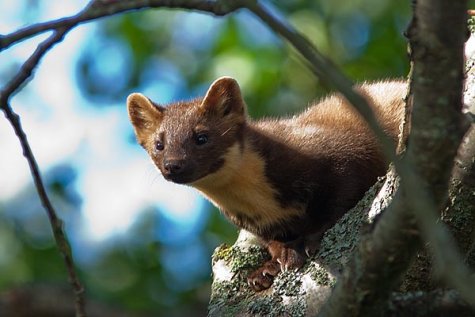Forest becomes more transparent
Photos Kaarel Kaisel
Translation: Liis
Pine marten
Pine marten; European pine marten Metsnugis Martes martes
Suitable habitats are larger forest areas as well as groves with dense undergrowth providing good hiding opportunities, felled tree trunks and tree hollows. The pine marten wears a valuable brown fur; on the throat and neck a yellowish or orange patch, which can extend to the forepaws but varies quite much individually. Lighter fur on the belly; length of the slim and flexible body less than half a metre, short legs that are suitable for climbing in trees, furry tail up to 30 centimetres long and the weight of the adult predator up to a couple of kilos. The estimated number certainly is below ten thousand.
Young animals left the mother’s care in late summer and became independent, searching for a suitable habitat for themselves – hence one meets them more often in autumn. It hunts from dusk to dawn, always moving on the ground; the predator feeds in autumn on lingonberries on the forest floor but it climbs in trees both to eat rowanberrries, to chase squirrels and to flee from enemies. From tree to tree it moves effortlessly in up to 3 metres long leaps. On the ground all burrows and all hollows under roots are thoroughly inspected; among rodents they hunt voles, bank voles (Myodes glareolus), yellow-necked mice and also water voles. In autumn they search for frogs on their way to hibernation. Pine martens are a threat to the wild hen family species. In winter they also feed on carcasses. The fox is regarded as the greatest enemy of pine martens- the cunning and larger creature can overcome them.
It marks its domains visibly with excrements, up to 5 centimetres long, twisted and tapering at both ends, left on tree stumps or fallen tree trunks; the territory is also marked with scent by secretion from the anal gland which is rubbed on to rocks, branches or grass tufts –animals sense olfactory markings even after a couple of weeks.
A century ago the pine marten had been hunted down to low population numbers. Gradually they began to be visible near forest farmhouses where they did mischief – visited farmyards to kill domestic fowl, even killing rabbits in cages. In recent decades pine martens have settled in garden cities and stands of trees in communities – the groves or larger parks must be connected somehow with forests nearby.
Nothing surprising, many other animal species have moved into the cities.









